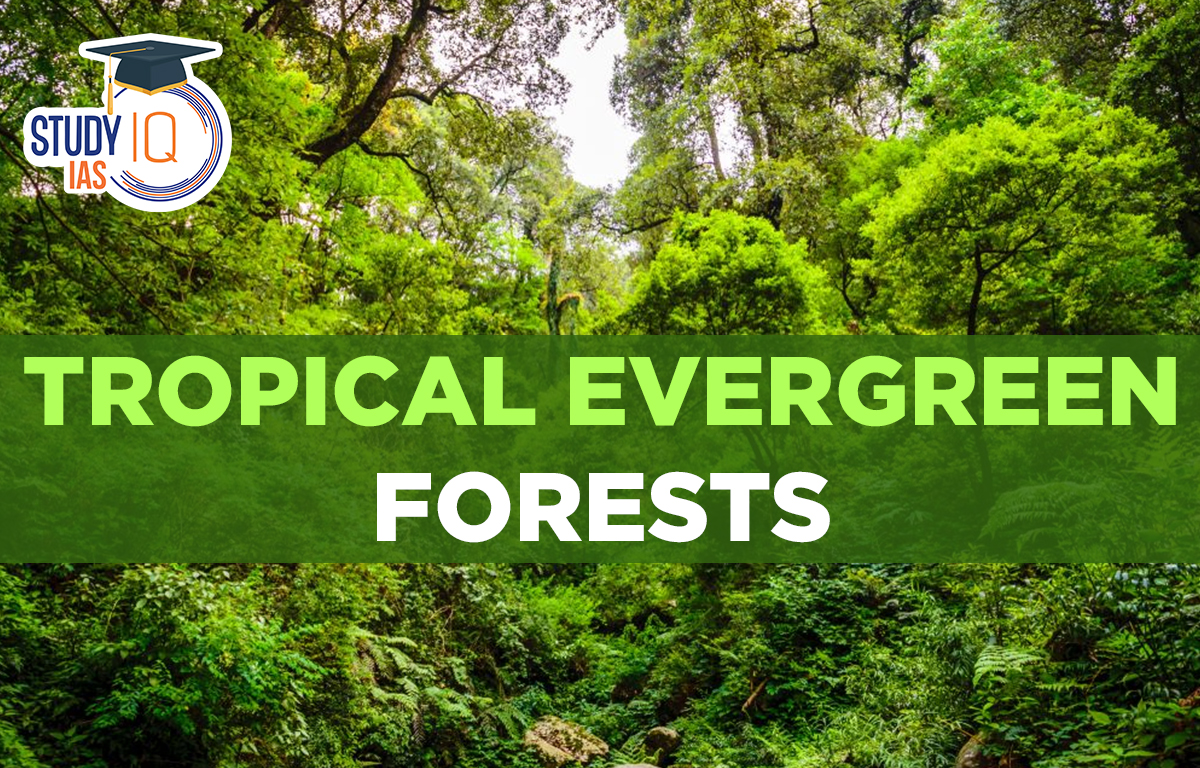Table of Contents
Tropical Evergreen Forests
The tropical evergreen forests in India are very important for wildlife. They provide homes for many birds, animals, and insects, including endangered species like owls, hawks, and mammals such as possums, raccoons, and deer. These forests also have unique trees and medicinal plants. You can find these forests in several places: along the Western Ghats, in the greater Assam region in the northeast, on the Andaman and Nicobar Islands, and along the coast of peninsular India. Below, we will discuss the features of these forests, the plants and animals living there, and where they are located.
| Tropical Evergreen Forest |
|
What is Tropical Evergreen Forest?
In India’s tropical regions, evergreen forests are the main type of plants. They grow best in places that get more than 200 cm of rain each year. These forests are very important for keeping the planet green and helping animals and plants survive. Because there is always enough water, the trees stay green all year. They are usually tall and made of strong wood.
Characteristics of Tropical Evergreen Forest
Tropical evergreen forests are characterized by the following:
- High Rainfall: Tropical evergreen forests get about 2000 mm of rain each year, which helps the trees grow tall and healthy.
- Dense Vegetation: These forests are very thick, with trees close together, creating a roof that blocks most sunlight and makes the area humid and shady.
- Wide Variety of Plant and Animal Life: Many plants and animals live in tropical evergreen forests, including trees, bushes, herbs, ferns, insects, birds, mammals, and reptiles.
- Multi-layered Structure: These forests have different layers. The tallest trees make the top layer, or canopy, which blocks sunlight. Below it are smaller trees and shrubs, then herbs and ferns, and finally a ground layer covered with leaves and branches.
- Abundant Epiphytes: Epiphytes are plants that grow on other plants without taking nutrients from them. These forests have many epiphytes like orchids, ferns, and mosses.
- Warm and Humid Climate: The climate in tropical evergreen forests is warm and humid, with temperatures usually between 25°C and 30°C all year.
Tropical Evergreen Forest in India Flora & Fauna
Tropical evergreen forests in India are located in the Western Ghats, the Andaman and Nicobar Islands, the upper parts of Assam, and the coasts of Tamil Nadu. These forests get a lot of rain, have thick plants, and support many types of plants and animals. They mainly have trees like Ebony, Mahogany, and Rosewood. Many different plants and animals live together, helping each other survive. This mix of life creates a unique environment, called a biome.
Tropical Evergreen Forest Animals
The animals in evergreen forests are special to these areas. You can find local birds like owls, hawks, and cardinals, as well as mammals like deer, possums, and raccoons. Tropical evergreen forests have many different kinds of animals, including:
- Mammals: Elephants, tigers, leopards, monkeys, apes, rhinos, deer, wild pigs, bats.
- Birds: Toucans, parrots, macaws, hornbills, hummingbirds, pheasants.
- Reptiles: Snakes, lizards, crocodiles, and turtles.
- Amphibians: Frogs, toads, and salamanders.
- Insects: Butterflies, beetles, ants, termites.
Tropical Evergreen Forest in India Geographical Location
Evergreen tropical forests in India were once large and full of plants and wildlife. However, human activity has shrunk them to areas like the river deltas of the Ganga, Godavari, and others. The Western Ghats forests cover parts of Maharashtra, Karnataka, Kerala, Goa, and Tamil Nadu. The Ganga delta has one of the world’s largest tidal mangrove forests, named after the Sundari tree.
Other dense tropical forests are found in the Andaman and Nicobar Islands, Assam, Odisha, and Meghalaya. These forests are crucial for keeping the environment green and supporting plants and animals. Many have become semi-evergreen due to human conflict and encroachment. To protect these vital areas, we need strict rules to limit human activity and help the forests recover.
The states where these forests are identified are:
- Tamil Nadu
- Kerala
- Karnataka
- Maharashtra
- Assam
- Arunachal Pradesh
- Nagaland
- Tripura
- Meghalaya
- West Bengal
- Andaman and Nicobar Islands
Threats to Evergreen Forests in India
Evergreen forests in India are threatened by a number of factors, including:
- Deforestation: Deforestation means cutting down forests to use the land for things like farming or building.
- Climate Change: Climate change is making the Earth’s temperature go up, leading to more severe weather like droughts and floods.
- Poaching: Poaching is the illegal hunting of animals.
- Encroachment: Encroachment is when people illegally take over forest land.
Conservation Efforts for Evergreen Forests in India
Many organizations are working to protect evergreen forests in India. They aim to reduce deforestation, fight climate change, and stop poaching and land invasion. We can help by using fewer resources like paper and wood, and by supporting these organizations. Here are some important efforts to conserve evergreen forests in India:
- Protected Areas: The Indian government has created national parks, wildlife sanctuaries, and biosphere reserves to protect evergreen forests. These areas provide safety for wildlife and help prevent deforestation.
- Joint Forest Management: Joint forest management (JFM) involves local communities in taking care of forests. This program has helped reduce deforestation and improve the lives of local people.
- Afforestation and Reforestation: The government is planting trees in damaged forests and barren lands to increase forest cover.
- Sustainable Forest Management: The government promotes sustainable practices like selective logging and harvesting non-timber products, ensuring forests are used wisely for future benefits.
- Climate Change Adaptation: The government is also helping forests adjust to climate change by planting drought-resistant trees and restoring damaged areas.


 Places in News for UPSC 2025 for Prelims...
Places in News for UPSC 2025 for Prelims...
 Story of Meera Bai and Her Devotion For ...
Story of Meera Bai and Her Devotion For ...
 Iron Ore, Types, Uses, Distribution in I...
Iron Ore, Types, Uses, Distribution in I...





















